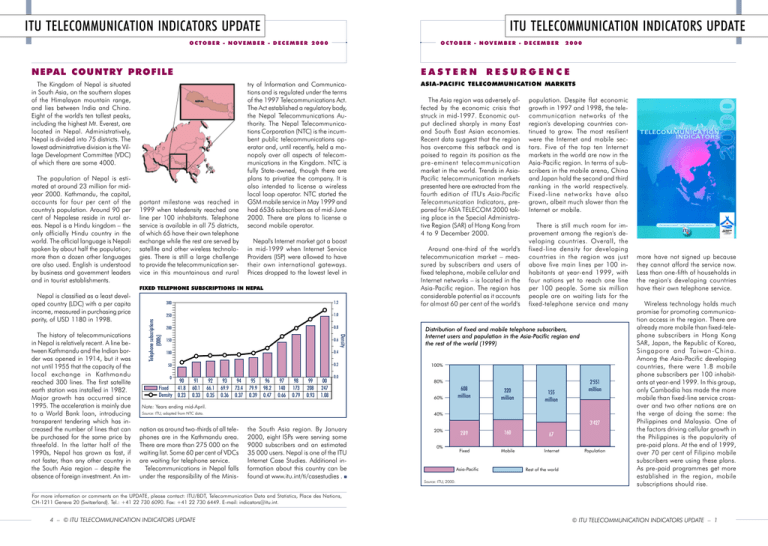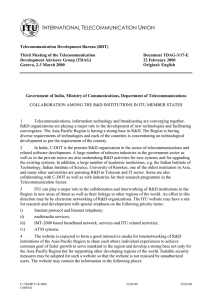ITU TELECOMMUNICATION INDICATORS UPDATE
advertisement

ITU TELECOMMUNICATION INDICATORS UPDATE ITU TELECOMMUNICATION INDICATORS UPDATE OCTOBER - NOVEMBER - DECEMBER 2000 OCTOBER - NOVEMBER - DECEMBER NEPAL COUNTRY PROFILE The Kingdom of Nepal is situated in South Asia, on the southern slopes of the Himalayan mountain range, and lies between India and China. Eight of the world's ten tallest peaks, including the highest Mt. Everest, are located in Nepal. Administratively, Nepal is divided into 75 districts. The lowest administrative division is the Village Development Committee (VDC) of which there are some 4000. The population of Nepal is estimated at around 23 million for midyear 2000. Kathmandu, the capital, accounts for four per cent of the country's population. Around 90 per cent of Nepalese reside in rural areas. Nepal is a Hindu kingdom – the only officially Hindu country in the world. The official language is Nepali spoken by about half the population; more than a dozen other languages are also used. English is understood by business and government leaders and in tourist establishments. EASTERN NEPAL portant milestone was reached in 1999 when teledensity reached one line per 100 inhabitants. Telephone service is available in all 75 districts, of which 65 have their own telephone exchange while the rest are served by satellite and other wireless technologies. There is still a large challenge to provide the telecommunication service in this mountainous and rural try of Information and Communications and is regulated under the terms of the 1997 Telecommunications Act. The Act established a regulatory body, the Nepal Telecommunications Authority. The Nepal Telecommunications Corporation (NTC) is the incumbent public telecommunications operator and, until recently, held a monopoly over all aspects of telecommunications in the Kingdom. NTC is fully State-owned, though there are plans to privatize the company. It is also intended to license a wireless local loop operator. NTC started the GSM mobile service in May 1999 and had 6536 subscribers as of mid-June 2000. There are plans to license a second mobile operator. Nepal's Internet market got a boost in mid-1999 when Internet Service Providers (ISP) were allowed to have their own international gateways. Prices dropped to the lowest level in 300 1.2 250 1.0 200 0.8 150 0.6 100 0.4 50 0.2 0 90 Fixed 41.8 Density 0.23 91 60.1 0.33 92 66.1 0.35 93 69.9 0.36 94 73.4 0.37 95 79.9 0.39 96 98.2 0.47 97 140 0.66 98 173 0.79 99 208 0.93 00 247 1.08 Density The history of telecommunications in Nepal is relatively recent. A line between Kathmandu and the Indian border was opened in 1914, but it was not until 1955 that the capacity of the local exchange in Kathmandu reached 300 lines. The first satellite earth station was installed in 1982. Major growth has occurred since 1995. The acceleration is mainly due to a World Bank loan, introducing transparent tendering which has increased the number of lines that can be purchased for the same price by threefold. In the latter half of the 1990s, Nepal has grown as fast, if not faster, than any other country in the South Asia region – despite the absence of foreign investment. An im- Telephone subscriptions (000s) FIXED TELEPHONE SUBSCRIPTIONS IN NEPAL Nepal is classified as a least developed country (LDC) with a per capita income, measured in purchasing price parity, of USD 1180 in 1998. 2000 RESURGENCE ASIA-PACIFIC TELECOMMUNICATION MARKETS The Asia region was adversely affected by the economic crisis that struck in mid-1997. Economic output declined sharply in many East and South East Asian economies. Recent data suggest that the region has overcome this setback and is poised to regain its position as the pre-eminent telecommunication market in the world. Trends in AsiaPacific telecommunication markets presented here are extracted from the fourth edition of ITU's Asia-Pacific Telecommunication Indicators, prepared for ASIA TELECOM 2000 taking place in the Special Administrative Region (SAR) of Hong Kong from 4 to 9 December 2000. Around one-third of the world's telecommunication market – measured by subscribers and users of fixed telephone, mobile cellular and Internet networks – is located in the Asia-Pacific region. The region has considerable potential as it accounts for almost 60 per cent of the world's population. Despite flat economic growth in 1997 and 1998, the telecommunication networks of the region's developing countries continued to grow. The most resilient were the Internet and mobile sectors. Five of the top ten Internet markets in the world are now in the Asia-Pacific region. In terms of subscribers in the mobile arena, China and Japan hold the second and third ranking in the world respectively. Fixed-line networks have also grown, albeit much slower than the Internet or mobile. There is still much room for improvement among the region's developing countries. Overall, the fixed-line density for developing countries in the region was just above five main lines per 100 inhabitants at year-end 1999, with four nations yet to reach one line per 100 people. Some six million people are on waiting lists for the fixed-telephone service and many Distribution of fixed and mobile telephone subscribers, Internet users and population in the Asia-Pacific region and the rest of the world (1999) 100% 0.0 80% 60% 608 million 320 million 155 million 2'551 million Note: Years ending mid-April. Source: ITU, adapted from NTC data. 40% 3'427 nation as around two-thirds of all telephones are in the Kathmandu area. There are more than 275 000 on the waiting list. Some 60 per cent of VDCs are waiting for telephone service. Telecommunications in Nepal falls under the responsibility of the Minis- the South Asia region. By January 2000, eight ISPs were serving some 9000 subscribers and an estimated 35 000 users. Nepal is one of the ITU Internet Case Studies. Additional information about this country can be found at www.itu.int/ti/casestudies . 20% 0% 289 160 67 Fixed Mobile Internet Asia-Pacific n Source: ITU, 2000. Rest of the world Population more have not signed up because they cannot afford the service now. Less than one-fifth of households in the region's developing countries have their own telephone service. Wireless technology holds much promise for promoting communication access in the region. There are already more mobile than fixed-telephone subscribers in Hong Kong SAR, Japan, the Republic of Korea, Singapore and Taiwan-China. Among the Asia-Pacific developing countries, there were 1.8 mobile phone subscribers per 100 inhabitants at year-end 1999. In this group, only Cambodia has made the more mobile than fixed-line service crossover and two other nations are on the verge of doing the same: the Philippines and Malaysia. One of the factors driving cellular growth in the Philippines is the popularity of pre-paid plans. At the end of 1999, over 70 per cent of Filipino mobile subscribers were using these plans. As pre-paid programmes get more established in the region, mobile subscriptions should rise. For more information or comments on the UPDATE, please contact: ITU/BDT, Telecommunication Data and Statistics, Place des Nations, CH-1211 Geneva 20 (Switzerland). Tel.: +41 22 730 6090. Fax: +41 22 730 6449. E-mail: indicators@itu.int. 4 – © ITU TELECOMMUNICATION INDICATORS UPDATE © ITU TELECOMMUNICATION INDICATORS UPDATE – 1


